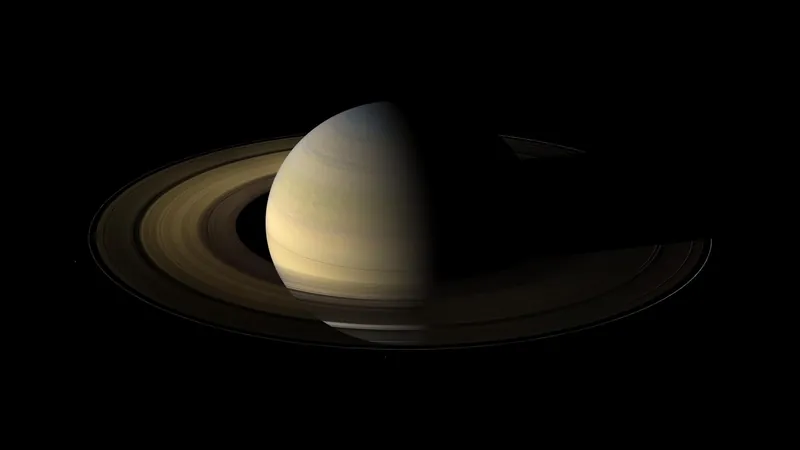
You Won't Believe Why Saturn's Rings Are Temporarily Invisible!
2025-03-23
Author: Mei
So, Why Are Saturn's Rings Invisible Right Now?
Fear not! Saturn’s rings haven’t truly disappeared; they’re just incredibly difficult to observe at this moment. This is primarily due to two factors: the tilt of Saturn itself and the remarkably thin nature of its rings.
Saturn's Rings Are Positioned at an Angle
Like Earth, Saturn is tilted; it rotates at an angle of about 26 degrees. This axial tilt leads to seasonal changes as the planet revolves around the Sun. For half of Saturn’s year, its southern hemisphere enjoys more sunlight, while the other half sees the northern hemisphere basking in solar rays.
Saturn experiences equinoxes, similar to Earth, marking the moments when both hemispheres receive equal sunlight. During these equinoxes, which only happen once every 14.5 Earth years, the rings align edge-on with the Sun. If you were to look at Saturn during one of these equinoxes, the rings would appear as a mere line rather than the breathtaking bands we are so used to seeing. The next equinox is approaching on May 6th, but we’re not quite there yet.
Interestingly, Earth's position relative to the Sun leads to a slightly different view. We’ll experience the edge-on view of Saturn’s rings much sooner, on March 23rd—six weeks ahead of Saturn's actual equinox.
The Rings are Astonishingly Thin
The rings of Saturn are incredibly thin compared to its colossal body. On average, the main rings only measure about 300 feet (approximately 100 meters) in thickness. In stark contrast, Saturn’s diameter spans about 70,000 miles (or 369,600,000 feet). In effect, when viewed edge-on, the rings become almost indistinguishable—much like trying to see something smaller than 1/100th the width of a human hair on a basketball.
When Do We See Saturn’s Rings Edge-On?
Due to their alignment, we can see Saturn's rings edge-on primarily around the equinoxes, which occur approximately every 14.5 years. Since Saturn is about 880 million miles from the Sun, a single orbit takes around 29.4 Earth years, making these rare alignments even more special.
At present, Saturn is too close to the Sun in the night sky, making it virtually impossible to observe. The next ring-plane crossing will occur in October 2038, with viewing still challenging due to proximity to the Sun. However, in 2054, both Earth and Saturn will be positioned on the same side of the Sun during a ring-crossing event, allowing for spectacular views.
A Future Without Rings?
Sadly, Saturn’s rings are not permanent fixtures. Over the course of the next 100 million years, they are expected to be pulled into the planet or its moons and eventually fade from existence.
Could New Rings Emerge?
Despite this inevitable disappearance, there is hope for the future! New rings may form from an event similar to a collision that created the current rings. Some scientists believe that remnants from past moon collisions have contributed to the rings we observe today. Additionally, Enceladus, one of Saturn’s moons, is active volcanically, with geysers that eject water vapor that freezes into tiny ice particles, contributing to the planet's E ring.
Fortunately, for those eager to catch a glimpse of Saturn’s stunning rings, their visibility will improve steadily until 2032, peaking during Saturn’s solstice when the southern hemisphere will shine like never before.
In summary, while the rings may be temporarily elusive, they’re far from gone forever. Stay tuned—your opportunity to witness Saturn’s iconic rings will return before you know it!



 Brasil (PT)
Brasil (PT)
 Canada (EN)
Canada (EN)
 Chile (ES)
Chile (ES)
 Česko (CS)
Česko (CS)
 대한민국 (KO)
대한민국 (KO)
 España (ES)
España (ES)
 France (FR)
France (FR)
 Hong Kong (EN)
Hong Kong (EN)
 Italia (IT)
Italia (IT)
 日本 (JA)
日本 (JA)
 Magyarország (HU)
Magyarország (HU)
 Norge (NO)
Norge (NO)
 Polska (PL)
Polska (PL)
 Schweiz (DE)
Schweiz (DE)
 Singapore (EN)
Singapore (EN)
 Sverige (SV)
Sverige (SV)
 Suomi (FI)
Suomi (FI)
 Türkiye (TR)
Türkiye (TR)
 الإمارات العربية المتحدة (AR)
الإمارات العربية المتحدة (AR)